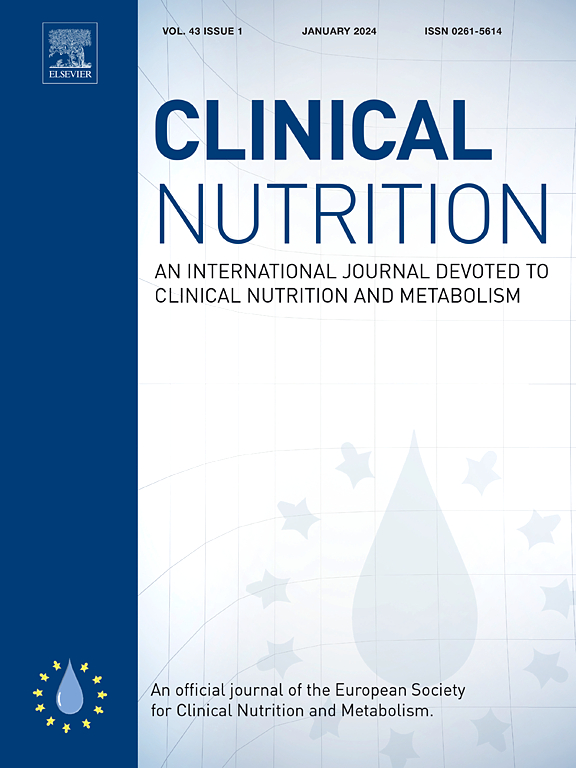24周监督同步运动干预对久坐不动的年轻成年人粪便微生物群多样性和组成的影响:ACTIBATE随机对照试验
IF 6.6
2区 医学
Q1 NUTRITION & DIETETICS
引用次数: 0
摘要
人类对运动有许多生理反应,但长期运动和不同强度运动对人类粪便微生物群多样性和组成的影响尚不清楚。我们研究了24周的监督并发运动干预,在中等和高强度下,对年轻人粪便微生物群多样性和组成的影响。方法本辅助研究基于ACTIBATE随机对照试验(ClinicalTrials.gov ID: NCT02365129)的数据,包括成年人(18-25岁,70%女性),随机分为(i)对照组(CON:不运动,n = 20), (ii)中等强度运动组(MOD-EX, n = 21)和(iii)高强度运动组(vige - ex, n = 20)。在24周运动干预前后采集粪便样本,通过16S rRNA测序分析粪便微生物群的多样性和组成。进行了粪便微生物群的推断功能分析,并评估了微生物变化与心脏代谢结果之间的相关性。结果无论运动强度如何,运动均未改变β和α多样性(P均≥0.062)。丹毒科(Bacillota门)的相对丰度为- 0.3±1.2%;P = 0.031),但在VIG-EX组降低。干预后,Coprococcus是MOD-EX与VIG-EX之间唯一有显著差异的属,其相对丰度在MOD-EX中增加(+0.4±0.6%);p = 0.005)。这些变化均与运动诱导的心脏代谢益处无关(均P≥0.05)。结论:在24周的监督下,在中等强度和高强度的运动中,年轻人的粪便微生物群组成发生了微小的变化,而α和β的多样性都没有受到影响。临床试验注册:clinicaltrials .gov ID: NCT02365129。本文章由计算机程序翻译,如有差异,请以英文原文为准。
Effect of a 24-week supervised concurrent exercise intervention on fecal microbiota diversity and composition in young sedentary adults: The ACTIBATE randomized controlled trial
Background
Numerous physiological responses to exercise are observed in humans, yet the effects of long-term exercise and varying intensities on the diversity and composition of human fecal microbiota remain unclear. We investigated the effect of a 24-week supervised concurrent exercise intervention, at moderate and vigorous intensities, on fecal microbiota diversity and composition in young adults.
Methods
This ancillary study was based on data from the ACTIBATE randomized controlled trial (ClinicalTrials.gov ID: NCT02365129), and included adults (aged 18–25 years, 70 % female) that were randomized to (i) a control group (CON: no exercise, n = 20), (ii) a moderate-intensity exercise group (MOD-EX, n = 21), and (iii) a vigorous-intensity exercise group (VIG-EX, n = 20). Fecal samples were collected before and after the 24-week exercise intervention, and the diversity and composition of the fecal microbiota were analyzed by 16S rRNA sequencing. Inferential functional profiling of the fecal microbiota was performed and correlations between microbial changes and cardiometabolic outcomes were assessed.
Results
Exercise did not modify beta or alpha diversities regardless of the intensity (all P ≥ 0.062). The relative abundance of the Erysipelotrichaceae family (Bacillota phylum) (−0.3 ± 1.2 %; P = 0.031) was however reduced in the VIG-EX group. Coprococcus was the only genus showed a significant difference between MOD-EX and VIG-EX after the intervention, with its relative abundance increasing in MOD-EX (+0.4 ± 0.6 %; P = 0.005). None of these changes were related to the exercise-induced cardiometabolic benefits (all P ≥ 0.05).
Conclusions
In young adults, a 24-week supervised concurrent exercise program, at moderate and vigorous intensities, resulted in minor changes in fecal microbiota composition, while neither alpha nor beta diversities were affected.
Clinical trial registration
ClinicalTrials.gov ID: NCT02365129.
求助全文
通过发布文献求助,成功后即可免费获取论文全文。
去求助
来源期刊

Clinical nutrition
医学-营养学
CiteScore
14.10
自引率
6.30%
发文量
356
审稿时长
28 days
期刊介绍:
Clinical Nutrition, the official journal of ESPEN, The European Society for Clinical Nutrition and Metabolism, is an international journal providing essential scientific information on nutritional and metabolic care and the relationship between nutrition and disease both in the setting of basic science and clinical practice. Published bi-monthly, each issue combines original articles and reviews providing an invaluable reference for any specialist concerned with these fields.
 求助内容:
求助内容: 应助结果提醒方式:
应助结果提醒方式:


